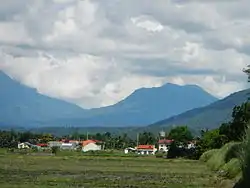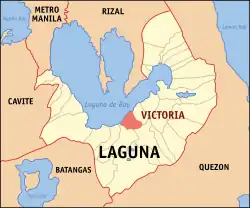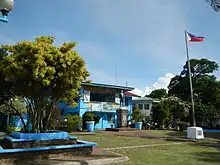Victoria | |
|---|---|
| Municipality of Victoria | |
 Victoria countryside with Mt. San Cristobal in the foreground | |
 Flag  Seal | |
| Nickname: Duck Raising Capital of the Philippines[1] | |
 Map of Laguna with Victoria highlighted | |
OpenStreetMap | |
.svg.png.webp) Victoria Location within the Philippines | |
| Coordinates: 14°13′30″N 121°19′30″E / 14.225°N 121.325°E | |
| Country | Philippines |
| Region | Calabarzon |
| Province | Laguna |
| District | 3rd district |
| Founded | November 15, 1949 |
| Named for | Victoria Quirino |
| Barangays | 9 (see Barangays) |
| Government | |
| • Type | Sangguniang Bayan |
| • Mayor | Dwight C. Kampitan |
| • Vice Mayor | Recto D. Kampitan Jr. |
| • Representative | Loreto S. Amante |
| • Municipal Council | Members |
| • Electorate | 29,744 voters (2022) |
| Area | |
| • Total | 22.35 km2 (8.63 sq mi) |
| Elevation | 14 m (46 ft) |
| Highest elevation | 212 m (696 ft) |
| Lowest elevation | 1 m (3 ft) |
| Population (2020 census)[4] | |
| • Total | 43,408 |
| • Density | 1,900/km2 (5,000/sq mi) |
| • Households | 11,943 |
| Economy | |
| • Income class | 4th municipal income class |
| • Poverty incidence | 3.75 |
| • Revenue | ₱ 130.7 million (2020) |
| • Assets | ₱ 276.9 million (2020) |
| • Expenditure | ₱ 130.5 million (2020) |
| • Liabilities | ₱ 83.93 million (2020) |
| Service provider | |
| • Electricity | Manila Electric Company (Meralco) |
| Time zone | UTC+8 (PST) |
| ZIP code | 4011 |
| PSGC | |
| IDD : area code | +63 (0)49 |
| Native languages | Tagalog |
Victoria, officially the Municipality of Victoria (Tagalog: Bayan ng Victoria), is a 4th class municipality in the province of Laguna, Philippines. According to the 2020 census, it has a population of 43,408 people.[4]
It is southeast of Laguna de Bay, 76 kilometers (47 mi) south of Manila and 11 kilometers (6.8 mi) from Santa Cruz. It is bordered by the Municipality of Calauan to the south-west, Nagcarlan to the southeast and Pila to the north-east. The municipality has a total land area of 22.83 square kilometers (8.81 sq mi) which is 1.30% of the total land area of the province of Laguna.
Duck Raising Capital of the Philippines, or Victoria, is a municipality offering some of the most bizarre yet delicious dishes including goats’ and ducks’ meat. The town is bordered by Calauan, Nagcarlan, and Pila. Following the town's nickname, the Itik Festival is celebrated, along with the town's founding anniversary, to give honor and to know more about the products that come from itik (duck).
Etymology
The name of Victoria means "victory" in Spanish. It got its name from Victoria Quirino, the daughter of former President Elpidio Quirino under whose presidency the municipality was established.[6] The younger Quirino also served as the First Lady as her father was a widower.
History
Prominent citizens and civic leaders found new hope to make Nanhaya, then a barrio part of Pila, a town, when the Americans granted the Philippines Independence in 1946. They revived the move to separate from Pila. During this time, citizens proposed to name the town Trinidad, after the young republic's First Lady, the wife of then-President Manuel Roxas. Strong oppositions shelved the proposal once more.
After Roxas's death, Elpidio Quirino took over the presidency. Nanhaya's residents remained undaunted. They tried once more, intensifying the campaign. Most prominent and wealthiest family of the town is the Fernandez clans, Judge Jose Fernandez, then Mayor Alejandro Fernandez, Atty. Ramon H. Fernandez Sr., Andres Franco, Dr. Agrifino Oca, Gregorio Herradura, and Leonardo Rebong stood for the proposal. On November 15, 1949, President Elpidio Quirino signed into effect Executive Order No. 282, segregating barrios Nanhaya, Bancabanca, Daniw, Masapang, San Benito, San Felix, San Francisco, and San Roque from Pila and formed a new independent municipality.[7]
After Pateros became highly urbanized and densely populated, Victoria became a destination of balut traders and became the "Duck Raising Center of the Philippines". The town was featured as the detour challenge of Leg 11 of the 5th Season of The Amazing Race. Victoria celebrates the Itik Festival every second week of November.
The municipal seat of Pila was once located in Barangay Pagalangan, now one of Victoria's barangays. The remains of Pila's original parish church can still be found in Pagalangan, which in the past made that community a target of treasure hunters seeking antiques. Pagalangan ceased to be Pila's capital when the town center was relocated due to frequent flooding.[8]
Barangays
Victoria is politically subdivided into 9 barangays. [9] Each barangay consists of puroks and some have sitios.
Currently, there are two barangays which are classified as urban (highlighted in bold).
Demographics
| Year | Pop. | ±% p.a. |
|---|---|---|
| 1960 | 8,922 | — |
| 1970 | 12,741 | +3.62% |
| 1975 | 13,810 | +1.63% |
| 1980 | 16,522 | +3.65% |
| 1990 | 21,847 | +2.83% |
| 1995 | 25,424 | +2.88% |
| 2000 | 29,765 | +3.44% |
| 2007 | 33,829 | +1.78% |
| 2010 | 34,604 | +0.83% |
| 2015 | 39,321 | +2.46% |
| 2020 | 43,408 | +1.96% |
| Source: Philippine Statistics Authority[10][11][12][13] | ||
In the 2020 census, the population of Victoria, Laguna, was 43,408 people,[4] with a density of 1,900 inhabitants per square kilometer or 4,900 inhabitants per square mile.
Economy
Government

Elected officials
| Name | Party | ||
|---|---|---|---|
| Mayor | |||
| Dwight C. Kampitan | Nacionalista | ||
| Vice Mayor | |||
| RJ Kampitan | Nacionalista | ||
| Municipal Councilors | |||
| Florencio M. Laraño | Nacionalista | ||
| Wilfredo Herradura | PDP–Laban | ||
| Ma. Fe B. Tope | PDP–Laban | ||
| Homer Herradura | Nacionalista | ||
| Sonny Lazaro | PDP–Laban | ||
| Analyn Nava | Independent | ||
| Jhon Paul D. Pahutan | Aksyon | ||
| Joselito D. Corcuera | PDP–Laban | ||
| Ex Officio Municipal Council Members | |||
| ABC President | Leoncio S. Fajardo (San Francisco) | ||
| SK President | John Patrick S. Cambe (Masapang) | ||
| SB Secretary | Caylene T. Fernandez | ||
References
- ↑ "Cadiz Duck Farm".
- ↑ Municipality of Victoria | (DILG)
- ↑ "2015 Census of Population, Report No. 3 – Population, Land Area, and Population Density" (PDF). Philippine Statistics Authority. Quezon City, Philippines. August 2016. ISSN 0117-1453. Archived (PDF) from the original on May 25, 2021. Retrieved July 16, 2021.
- 1 2 3 Census of Population (2020). "Region IV-A (Calabarzon)". Total Population by Province, City, Municipality and Barangay. Philippine Statistics Authority. Retrieved July 8, 2021.
- ↑ "PSA Releases the 2018 Municipal and City Level Poverty Estimates". Philippine Statistics Authority. December 15, 2021. Retrieved January 22, 2022.
- ↑ "Pagdiriwang ng Itik Festival sa Victoria, Laguna, naging matagumpay". Philippine Information Agency (in Tagalog). November 18, 2022. Archived from the original on February 1, 2023. Retrieved February 1, 2023.
- ↑ Executive Order No. 282, s. 1949 (October 14, 1949), "Organizing Certain Barrios of the Municipality of Pila, Province of Laguna, Into an Independent Municipality Under the Name of Victoria" (PDF), Official Gazette of the Republic of the Philippines, retrieved August 4, 2023
- ↑ de Leon, Remi E. (2005). "Health Knowledge Processes and Flows in a Coastal Community in Victoria, Laguna Philippines". University of the Philippines Los Baños Graduate School.
Master's Thesis
{{cite journal}}: Cite journal requires|journal=(help) - ↑ "Province: Laguna". PSGC Interactive. Quezon City, Philippines: Philippine Statistics Authority. Retrieved November 12, 2016.
- ↑ Census of Population (2015). "Region IV-A (Calabarzon)". Total Population by Province, City, Municipality and Barangay. Philippine Statistics Authority. Retrieved June 20, 2016.
- ↑ Census of Population and Housing (2010). "Region IV-A (Calabarzon)" (PDF). Total Population by Province, City, Municipality and Barangay. National Statistics Office. Retrieved June 29, 2016.
- ↑ Censuses of Population (1903–2007). "Region IV-A (Calabarzon)". Table 1. Population Enumerated in Various Censuses by Province/Highly Urbanized City: 1903 to 2007. National Statistics Office.
{{cite encyclopedia}}: CS1 maint: numeric names: authors list (link) - ↑ "Province of Laguna". Municipality Population Data. Local Water Utilities Administration Research Division. Retrieved December 17, 2016.
- ↑ "Poverty incidence (PI):". Philippine Statistics Authority. Retrieved December 28, 2020.
- ↑ "Estimation of Local Poverty in the Philippines" (PDF). Philippine Statistics Authority. November 29, 2005.
- ↑ "2003 City and Municipal Level Poverty Estimates" (PDF). Philippine Statistics Authority. March 23, 2009.
- ↑ "City and Municipal Level Poverty Estimates; 2006 and 2009" (PDF). Philippine Statistics Authority. August 3, 2012.
- ↑ "2012 Municipal and City Level Poverty Estimates" (PDF). Philippine Statistics Authority. May 31, 2016.
- ↑ "Municipal and City Level Small Area Poverty Estimates; 2009, 2012 and 2015". Philippine Statistics Authority. July 10, 2019.
- ↑ "PSA Releases the 2018 Municipal and City Level Poverty Estimates". Philippine Statistics Authority. December 15, 2021. Retrieved January 22, 2022.
.svg.png.webp)